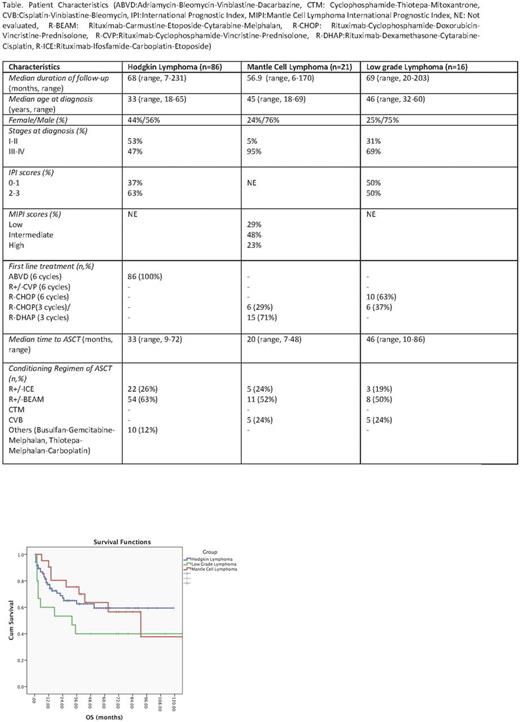Abstract
Introduction: Autologous stem cell transplantation (ASCT) is employed successfully at different settings in lymphoma. Most of the patients have been achieving durable remission rates with long term survival. Herein, our aim is to report outcomes of our relapse refractory Hodgkin lymphoma (HL) and non-Hodgkin lymphoma (NHL) patients who underwent ASCT.
Methods: We retrospectively evaluated 86 relapse refractory HL, 21 mantle cell lymphoma, 16 low grade lymphoma (n=12 follicular lymphoma, n=4 marginal zone lymphoma) patients who underwent ASCT between 2005-2015. The patients were followed after ASCT for relapse.
Results: The baseline characteristics of patients are given in the table. The patients were diagnosed as nodular sclerosing subtype most frequently in HL group (75%). In HL group, 27 patients (32%) had chemo-refractory high risk disease prior to ASCT. On the other hand, all patients in mantle cell and low grade lymphoma groups were in at least partial remission at the time of ASCT. In HL group, at a median time of 28 months after ASCT (range, 1-119), 51 patients (60%) achieved complete remission, 7 patients had partial remission (8%), 28 patients (32%) had stabile disease or progression/relapse. The response was higher in patients with early stage disease (I-II), remission status prior to transplant and BEAM conditioning regimen compared to advance stage (III-IV) (p=0.017), active disease prior to transplant (p=0.008) and other conditioning regimens (p=0.05). Nine patients (10%) died within three months of ASCT due to infection. From 28 patients, 5 patients received brentixumab, 3 patients received nivolumab, 10 patients had GDP, 10 patients had MOPP regimen. Four patient underwent allogeneic stem cell transplantation. Fifty four out of 58 (93%) patients transplanted with responsive disease were alive without disease whereas 4 out of 28 (14%) patients with unresponsive disease were alive in remission within 3 years post ASCT. In low grade lymphoma group, 9 patients (56%) achieved complete remission after ASCT. Interestingly, complete response rate was higher in females (80% vs 43%, p=0.35). Five patients (31%) died within three months of ASCT due to infection. Two patients (13%) relapsed with a median time of 8 months (range, 3-13 months) and received MINE as salvage treatment and followed in complete remission. The 3-year overall survival was 51%, 5-year overall survival was 40%. In mantle cell lymphoma group, 6 patients (29%) achieved complete remission. Four patients (19%) died within three months of ASCT due to infection. Eleven patients (52%) was relapsed with a median time of 39 months (range, 4-123 months). Ten patients received BORID (bortezomib, rituximab, dexamethasone) and 1 patient received lenalidomide as salvage therapy and six of them achieved complete remission. Three patients underwent allogeneic hematopoietic stem cell transplantation as well as two patients received ibrutinib as fourth line therapy and followed in remission. The 3-year overall survival was 71% (Figure).
Conclusion: In our experience, ASCT is a feasible option in patients who responded showing long term durable complete remission rates. In Hodgkin lymphoma, patients with BEAM conditioning, remission status prior to ASCT and early stage disease had better response rates. Females achieved higher responses in low grade lymphomas. However, 10% of HL, 31% of low grade lymphoma and 19% of mantle cell lymphoma patients were died because of treatment related toxicity. Candidate patients should be evaluated carefully. Today, novel agents may present a less intensive approach for achieving response.
Ilhan: Novartis: Consultancy.
Author notes
Asterisk with author names denotes non-ASH members.


This feature is available to Subscribers Only
Sign In or Create an Account Close Modal